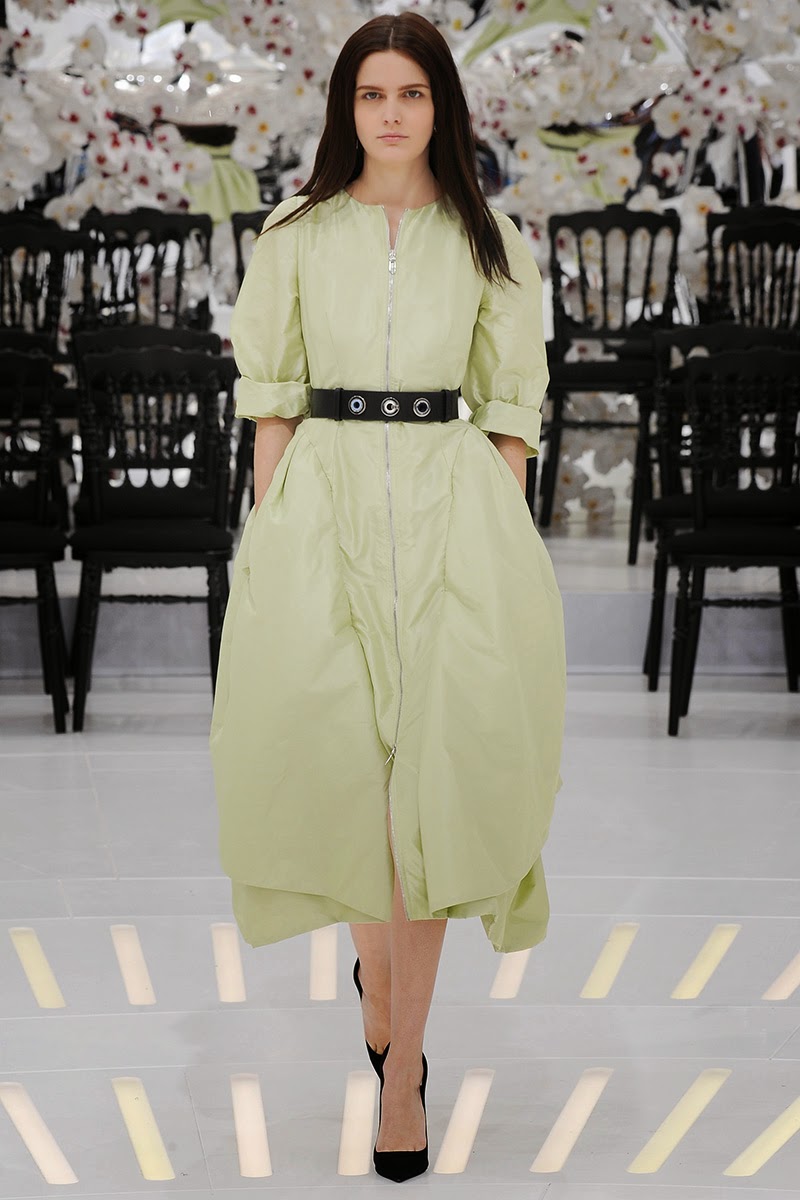“I was interested in the process of finding something extremely modern, through something very historical; particularly through a juxtaposition of different themes,” explains Raf Simons.“The historical inspiration is not the justification of the collection, it isn’t its entire meaning. What I was attracted to was an idea of architectural construction – that is a very Dior attitude – and how the foundations of one era are based on another, how the future is based on the past; that is what I found fascinating.”
Enjoy the DIOR F/W '14/15 Haute Couture runway video at the end of this post!
LoL, Andrea
The providence of DIOR Fall/Winter '14/15 Couture: looking forwards and backwards to prepare for the future. In the Autumn-Winter collection, Raf Simons, Artistic Director of Christian Dior, instigates an exploration of the past combined with ideas of a near future, to look for what it means to be modern in the contemporary haute couture world today.
Eschewing strict historical accuracy and embracing an amalgamation in the imagination, the collection is nevertheless split into eight distinctly different sections, each a variation on a theme. The historical sprawl of the collection spans influences from the 18th Century onwards; it takes in 18th Century French court attire of both sexes and similarly synthesises ideas from the uniforms of both cosmonauts and astronauts up until the present day – the astronaut is a symbol of exploration for Simons and flight a reoccurring leitmotif in the collection.
The theme and variation structure proceeds as follows: Robe a la Française: A variation on traditional dresses of the 18th Century; an amalgam of styles mostly worn with panniers, lightened with new tulle structures. Flight a la Française: Here the flight suit meets the traditional dress; bodices and embroidery transposed at times, zippers and silk taffeta utilised. 1910s Linear: Sinuous, long line coats with an Edwardian origin, travelling through history. Bodice meets Jacket: The transposing of technical details, employed at the service of structural form; bodices become skirts, jackets become blouses, smocking structures. Justacorps and Gilets: Masculine ‘court coats’ of the 18th Century adapted for the feminine form. 1920s Liberated: Loose, ‘flapper’ lines of the twenties reimagined in tour de force embroideries. Collar meets Bar: The Dior archive at its most abstract and geometric; pure volumes and shapes originating from 1950 are elaborated on, highlighting Christian Dior’s architectural purity of form. Techniques, Pleats and Systems: An approach to decoration where tradition and technology combine; traditional piping becomes indivisible from the systems of astronaut suiting.
The collection pushes the couture atelier to the extremes in its utilisation of a plethora of traditional techniques and their modified applications. This can entail transferring and transposing technical functions to decoration, embellishment to structure, and the revelation of entirely new methods for the first time. For instance, embroideries can find their origins in 18th Century masculine dress, such as in the ‘court coats’ that are presented, or be made completely new in the shaggy structural form of resin punctuated fringe; covering a ‘neo-flapper’ dress, this new technique is called ‘alien fur’ by the atelier.
Effectively, eight mini collections took their turns, in groups: bouncy eighteenth-century influences, party dresses with tiny waists; long edwardiana coats and furs, sweeping to the ground; techno jumpsuits with flower embroidery and zippers; little white suits with tab hems; pretty chiffon cocktail frocks, and so on. “Just suggestions,” Simons shrugged when asked why he sent out so many distinct passages.“I started to think ‘what is modern’? I wanted to deal with a form language that looks to be almost the opposite of my original inspiration at Dior,” says Raf Simons. “It was an idea of confronting what people now think is an aesthetic that is modern – it felt more modern to go to the far past, not the ‘modernised ‘look of the last decade. The challenge was to bring the attitude of contemporary reality to something very historical; bringing easiness to something that could be perceived as theatrical.It is the attitude that matters.”
There were really beautiful things: delicate yellow, cream, and Fragonard blue dresses with flower embroidery, a plethora of eighteenth-century frock coats, shown over narrow black pants. Still, you detect his intellectual point in all this. Simons refuses to play the role of designer as monomaniacal fashion dictator. He also clearly wants to disrupt the conventions which have grown up around runway shows.
Selections by ANDREA JANKE Finest Accessories
Photo Credit/Source: The House of DIOR
&
More To Love ...
The Atelier Versace show is the first of the Paris haute couture season, showing Donatella Versace’s clothes which will be hand-made, to measure, for individual customers and delivered to them to wear in the fall. “Hot couture!” she purred, as she appraised the extraordinary coming together of a double duchess ball gown skirt and black Lurex corseted bodysuit complete with a gilt metal choker that was about to take to her runway.
Photo by ANDREA JANKE via Instagram






































































No comments:
Post a Comment